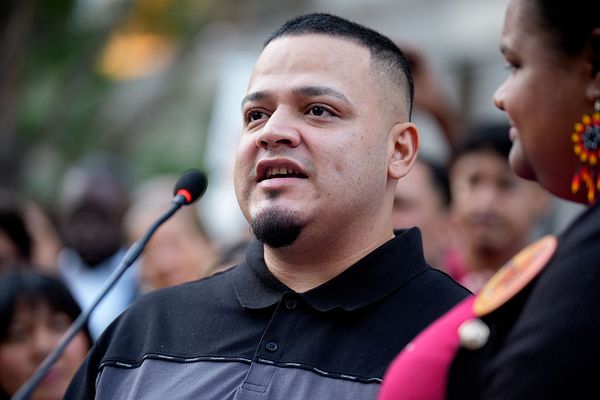LOS ANGELES -- Wendy Klenk never considered herself a political person. But when she witnessed a towering and healthy ficus tree being cut down in Beverly Hills last week, something fired up within her.
"I've never done anything like this," she said on a recent morning, walking from business to business on the 100 block of Robertson Boulevard collecting signatures to save the trees. "But I feel responsible for the land, and I felt compelled to act." She's called and emailed city hall. She's addressed the city council in tears, hoping for answers and alternatives.
Robertson Boulevard, one of the city's major commercial corridors, is in the midst of a dramatic face-lift. Some 87 ficus trees, also known as Indian laurel figs, will be cut down for a sidewalk restoration project. The city and some business owners blame the majestic trees for leaving messy droppings and damaging buildings and sidewalks.
"There have been several trip and fall claims over the last few years and we can no longer repair the sidewalk without replacing it, which requires eight inches of excavation and would destabilize the trees," said Lauren Santillana, the city's public information manager, in an email. "With the uplift of the sidewalk, there have also been drainage issues."
Officials aim to replace the ficus trees — the oldest about 60 years old — with alternating crape myrtles and Mexican fan palms. The cost to remove and replace them is approximately $226,000.
The Robertson Sidewalk Improvements project will include the removal and replacement of sidewalks, curb ramps and more, and the installation of an irrigation system and electrical outlets for the city trees.
Other tree removals in Beverly Hills are also in progress, but those are related to wind, decline and other things, Santillana said. "All of the city's cumulative removals are less than 1% of the city's tree inventory."
A similar project and battle are underway in Long Beach.
The projects come at a time when cities across the nation are being urged to expand their tree cover.
Experts agree that trees are among California's best defenses against human-caused climate change. Global warming is making summers more brutal, and extreme heat is killing far more Californians than the state acknowledges. Not only do trees filter pollutants from air and quell storm water runoff, they also help cool surface temperatures during extreme heat waves with shade and transpiration.
"Those two combined processes can result in black asphalt surfaces that otherwise could be 140, 150 degrees in L.A., or out in Coachella 170 degrees, to be cooled down, in Coachella, about 100 degrees, and in L.A. down to 80 degrees," said Janet Hartin, an environmental horticulture advisor with the UC Cooperative Extension in Los Angeles, San Bernardino and Riverside counties.
Yet when trees are not being killed off by drought, disease and insects, many mature shade trees that offer more environmental benefits are being cut down. Less than half of the trees planted in urban settings live to be 20 or 30 years old because of poor tree selection and care, Hartin said.
"As climate change and urban heat islands become more prevalent, we [start to] have a health issue," she added, and poor communities bear the brunt.
For some business owners, the tree removals are bittersweet. For others, it feels like a death in the family.
"Now the neighborhood looks like a graveyard," lamented Alex Asadi, an attorney with an office on Robertson Boulevard.
"These trees were part of the community," Klenk added.
Known historically as the "workhorses" of urban canopy, the nonnative species were planted in vast numbers in the 1950s and '60s across cities from San Diego to San Luis Obispo, shaping Southern California's appearance.
They gained popularity as an evergreen tree and were hailed for their ability to prosper in tough urban environments.
Today, their adaptability has caused them to be targeted for removal, according to Bryan Vejar, community forestry foreman for the environmental advocacy organization TreePeople.
Among an urban tree's greatest challenges is soil compaction — when soil becomes so compressed it impedes the transportation of water and air. That can cause oxygen deficiency and stymie root growth.
Ficus trees don't have that problem.
"The ability of the ficus tree roots to push past that compacted soil deeper down underneath the hardscape, underneath the sidewalks and streets and around utilities to find that soil moisture, to find that space to anchor itself, it's an adaptation of the ficus tree," Vejar said. "But also it means it's quite destructive for all the sidewalks and other utilities nearby."
That destruction has cost Debra Carter thousands of dollars in recent years.
A showroom manager for Carter Hardware on Robertson Boulevard, Carter estimated the business has paid some $15,000 to remove tree roots from their alley, clean leaf-clogged drainage pipes and more.
"We've had floods regularly in the show room," she said. That's in addition to the rats, gnats and ants the tree attracted to their building.
"We love trees, but this particular one, I'm not sad about it," she said, pointing to a barren square of soil outside the storefront, where a roughly 40-foot ficus once soared.
For Cocoe Voci, owner of a bridal atelier, the tree removals were bittersweet. She appreciated the shade the tree once provided, but it clogged drainage pipes and wrecked her ceiling. She wasn't happy about the $2,000 expense to replace, replaster and repaint it.
"I really love trees, but I have mixed feelings because of how they damaged the buildings and streets," she said. She was also concerned seniors and people with disabilities could trip and fall on the uneven sidewalk. She signed the petition to save the trees anyway.
Another community effort from 2019 is partly responsible for the current misfortune of Robertson Boulevard's ficus trees.
In a petition letter to Ken Pfalzgraf, the city's urban forest manager, property owners along the 100 block of North Robertson Boulevard urged the city to remove and replace the block's trees.
"We need to immediately rethink the landscaping plan for Robertson Blvd-North of Wilshire," wrote a fed up business owner. "The existing Ficus trees have been a huge concern as they have caused substantial sidewalk damage on both sides of Robertson as well as damage to the façade, foundation, and plumbing to buildings on the street. Although the city has been proactive to reduce trip hazards in the past, the sidewalks continue to shift due to the natural growth of these tree species."
In an email, Santillana said the city hand delivered the project notice to businesses along Robertson in July and mailed the tree removal notice to those within a 500-foot radius of the project.
But some businesses said they didn't know. Others thought the trees would just be trimmed. Few realized how dramatically, and how quickly, it would alter the block.
"Now there's too much sunlight and our building is burning," said Michy Silverstein, manager of the appliance store Miele. "We've had to turn on the air conditioner."
Many impassioned tree lovers have wondered: "Why kill perfectly healthy trees when you can replant them?" That's not a feasible option, Vejar said.
For one, trees adapt to the amount of shade, wind, drainage and soil microbial life of their locations. It has "basically responded to all of the environmental stimuli around it to grow in a certain way to be specific to that one site," he said.
When transplanting does happen, which is usually reserved for historical, protected or endangered species, the site has to be prepared years in advance. Once the tree is replanted, "it has an uphill battle, it has to re-acclimate… You can potentially put tens of thousands of dollars in all this work and resources into moving these trees only to have them go into transplant shock and decline."
Santillana said the city would have needed to excavate 20 feet in diameter around the tree and five feet below to replant each tree. "Therefore, the impact would have been infeasible."
As cities adapt their environments to combat the effects of climate change, planting a diversity of drought-tolerant native and non-native trees that can also withstand extreme heat will be critical, experts say. Selecting the right trees and properly caring for them will be, too.
"Because if the trees fail, and they die when they're 10 or 20 years old, then you start all over again, and the maximum ecosystem benefits are never realized," Hartin said. "They're going to be maximized when the tree is several decades old — that's when it provides the most shade.
"So if we're not taking care, not planting the right species, the trees die. We're back to ground zero," she said. "And we don't have time to keep doing this."







